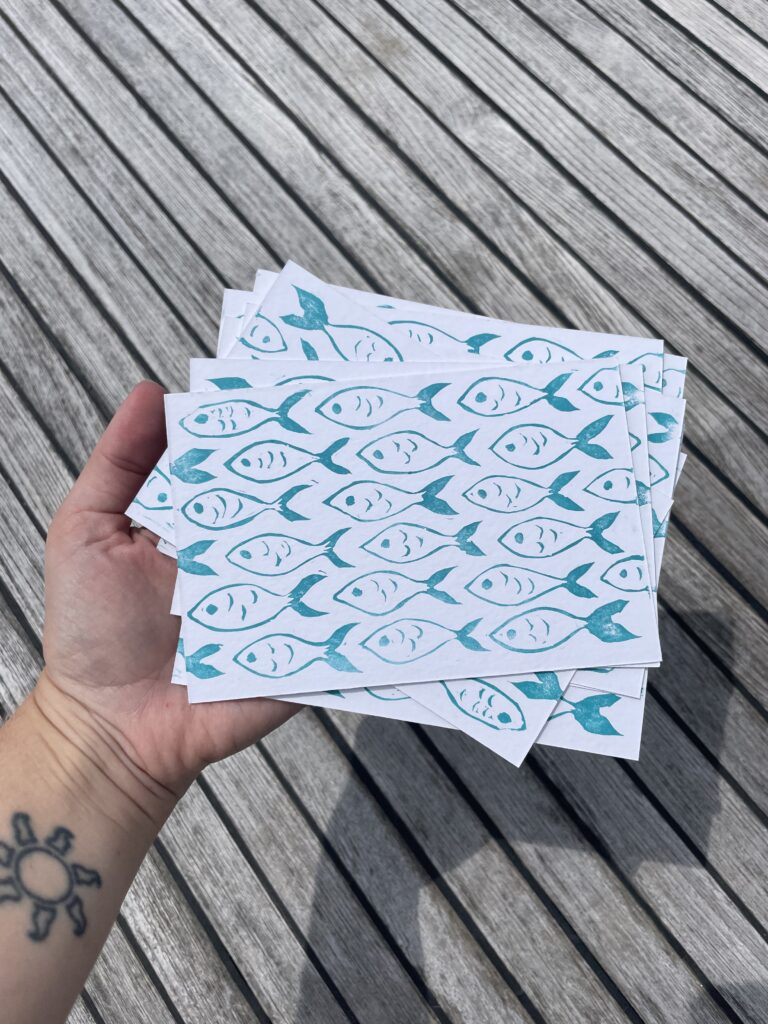Patreon
The Postcard Project is my patreon subscription that’s all about connection. This project was born out of my desire to create art that brings people together in a way that goes deeper than a social media “like”. With this tier, you will receive a little parcel in the mail each month. Who doesn’t love getting something in your physical mailbox that isn’t a bill or a bank statement??
The parcel will include a hand-printed postcard with an original design that is exclusive to the Postcard Project. The postcard will be blank, so you may either pass it on by mailing it to someone in your life, or you may keep it as a collectable. Either way, I hope it will inspire you to send your own snail mail. In addition to the postcard you will receive a newsletter. The newsletter will be general musings, philosophies and food for thought from my wonky lil brain. If you feel inspired to, I hope you’ll write back with your thoughts.
Below is an example of one of my Patreon letters!
Sample letter:
Ahoy!
Happy September! As always, thank you SO much for being here. This little community I’m building is bringing me so much joy, and I hope the postcards and newsletters are doing the same for you.
In case you missed it – August’s bonus Patreon video is uploaded. It’s titled “The BEST Parts of Boat Life”, and it guest-stars my friend Eddy, who lived with me on board for the past few months. We filmed our conversation on a dreary gray morning, and talking about our favorite aspects of living aboard seemed to brighten the boat up a bit.
In our conversation we discussed a number of things, but there were a couple of prominent themes that came through. One of my main takeaways from our conversation was that we really enjoy our proximity to the natural world (especially the loons!). I’ve listened to a lot of interviews with liveaboard sailors and read many sailing books, and this theme tends to be something that really draws people to the lifestyle.
I hesitate every time I say that I enjoy being “closer to nature” or “in nature”. This hesitation comes from one of my college professors, who challenged me to think about that language. Where do humans end and where does nature start? When we say that we want to go for a hike to be “in nature”, how are we separating ourselves from nature?
This also ties into an idea that I was first introduced to by reading the work of Kendra Pierre-Louis — a climate reporter and journalist. The idea is based on a realization that many of us perceive humanity’s collective relationship with the planet as negative. Basically — humans are killing the planet. And this message is reinforced by much of the movies and TV that we consume (examples she gives include WALL-E, and Avatar). But, in her words, Pierre-Louis says “We need different stories, ones that help us envision a present in which humans live in concert with our environment. One in which we eat, play, move, and live in ways that are not just lighter on the Earth but also nurturing to us as humans.”.
These ideas feed into each other perfectly. What if we could change our thinking? Rather than humans being a separate, opposing force that destroys nature — what if we saw ourselves as part of nature? In this framework we live within the flow of natural cycles harmoniously. Maybe we shift our thinking to ways that we can work with our natural environment instead of against it. We could shift from a state of dominance and control to harmony, connection and regeneration.
What could this perspective shift look like in practice? What physical changes could come from it? The closest place to start is to think of what our homes would look like, and there’s no area that we like to “conquer” more than our lawns. So perhaps this looks like more No-Mow Zones, allowing Mother Nature to assist us in our landscaping efforts. Moving inside our homes, how can we be more efficient about the ways we heat and cool? It’s amazing to see architects who are changing the way they design buildings to work with the ecosystem they are in, but there are plenty of ways that we can work within what we already have, too.
But I digress, this isn’t a newsletter about lawns or home design, though those are interesting lenses to look through. Rather, it’s about reframing our outlook on how we as humans fit into the beautiful and harsh natural world. So I suppose I’ll close by prompting you to see how it feels to view yourself not as separate from “nature”, but as a part of it. And maybe spend some time just wondering – how can I live more in a state of flow with it, rather than against it.
Fair Winds,
Hannah
Ps. To read Kendra Pierre-Louis’ article search: ‘Wakanda Doesn’t Have Suburbs’: How Movies Like Black Panther Could Help Us Save the Planet – it’s a fascinating read.
